The era of digital transformation bringing significant pressure to deliver software more rapidly, more reliably, and more adaptable to evolving business needs, organizations have shifted from classical monolithic architectures towards microservices—a new architectural style based upon applications built as a suite of loosely connected, independent-deployable services.
Though Microservices Architecture provides significant advantages including scalability, fault isolation, and diversity in the use of technology, it also adds a great deal of complexity, particularly in software quality assurance (QA).
In contrast to monolithic architectures where the entire application can be tested as a whole by the QA team, microservices require new techniques and tools. Every service needs to be tested individually and within the system as a whole. Inter-service communication, data integrity, asynchronous workflows, deployment pipelines, and system observability are all important QA concerns.
In addition to this, as companies implement DevOps and CI/CD pipelines, the significance of automating testing, incorporating quality checks early in the development cycle (shift-left) and monitoring production environments constantly intensifies.
Understanding the Microservices Architecture
Microservices Architecture is a software development methodology where a big application is made up of a collection of small, loosely coupled, independently deployable services. Each service owns a separate business capability and talks to other services using lightweight protocols such as HTTP/REST or message queues.
Core Principles of Microservices Include:
- Single Responsibility: One service does a thing well.
- Independence: They can be independently developed, deployed and scaled.
- Decentralized Governance: Teams use the technologies appropriate to their services.
- Continuous Delivery: Services are automated and released constantly and repeatedly.
Contrast with Monolithic Architecture
In Monolithic Architecture, the UI, business logic and database access are all merged into a unified codebase and shipped as one entity. Such monolithic deployment can lead to bottlenecks and scalability issues.
For more information, please refer detailed guide: Monolithic vs Microservices Architecture – Choosing the Right Approach
Key QA Challenges in Microservices Architecture
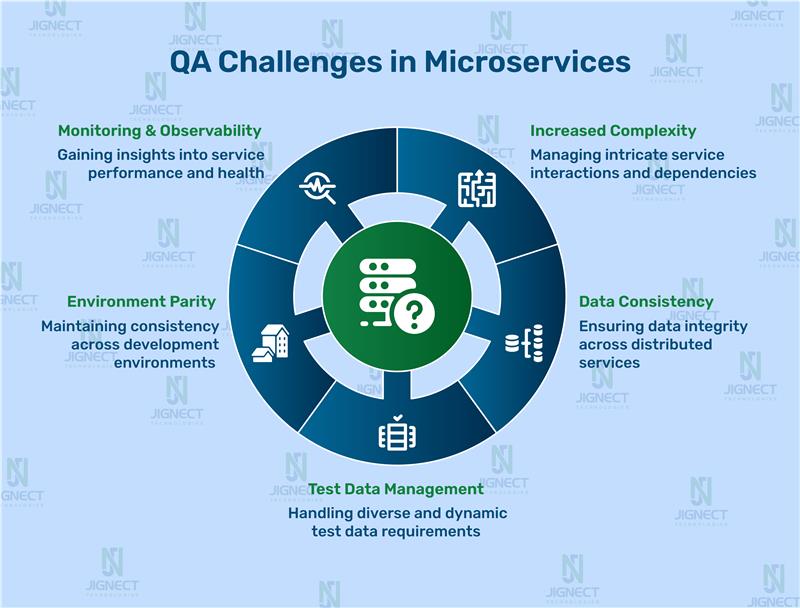
As more organizations transitioning from monolithic to microservices architectures, software quality assurance gets much more complex. Microservices are more agile, more scalable, and more flexible but they also come with a host of testing and QA issues owing to their distributed nature.
Following are the biggest challenges you can expect to face and how to handle them.
Increased Complexity
In a microservices architecture, you are no longer testing one application but testing many individually deployable services with their own codebases, CI/CD pipelines, dependencies, and runtime behavior.
Why it’s challenging:
- A change in one service might break another.
- Dependency mapping is no longer trivial.
- End-to-end testing is challenging because communication is asynchronous.
Real-world example:
A modification in the Product Service can inadvertently impact the Cart Service or the Recommendation Engine notwithstanding having different teams behind each service.
Solution:
- Maintain clear API contracts.
- Use tools like Pact for contract testing.
- Automate integration tests in your CI pipeline.
Data Consistency and Communication Across Services
Every microservice usually owns its own database, encapsulating logic but causing a problem when operations extend across more than a single service.
Why it’s challenging:
- No common transactional scope between services.
- Risk of inconsistent system states resulting from operation failures.
Real-world example :
While making the order, the system will update the Inventory Service, Order Service, and Payment Service. Should the payment process fail but the inventory already got deducted, then you have a data integrity issue.
Solution:
- Use event-driven architecture (e.g., RabbitMQ, Kafka).
- Use Saga pattern or compensating transactions.
- Use eventual consistency with proper auditing.
Test Data Management
With distributed services, creating and maintaining consistent test data across services is more complex than populating a single database.
Challenges:
- Data models vary based on service.
- Services can operate on isolated environments or containers.
- Making repeatable and isolated testing environments is difficult.
Solution:
- Utilize tools such as TestContainers for dynamic containerized databases in testing pipelines.
- Standardised test data contracts or shared fixtures.
- Build data seeding APIs for local/stage environments.
Environment Parity (Local ≠ Stage ≠ Prod)
Microservices tend to act differently in environments based on:
Challenges :
- Configuration drifts.
- Obsolete service versions.
- Missing dependencies.
Solution:
- Use Docker Compose or Kubernetes (with minikube) to replicate the production topology locally.Functional
- Use infrastructure as code (IaC) to standardize environments (e.g., Terraform, Pulumi Isolate new functionality in production using feature flags.
Monitoring & Observability
Microservices are a black box without observability. A user request may touch 10+ services before responding and if it does break, tracing the problem would be equivalent to looking for a needle in a haystack.
Challenges :
- Centralized Logging.
- Distributed Tracing.
- Custom Metrics and Dashboards.
Solution :
- Get end-to-end visibility across services and address issues before they are discovered by users.
QA Strategies for Microservices
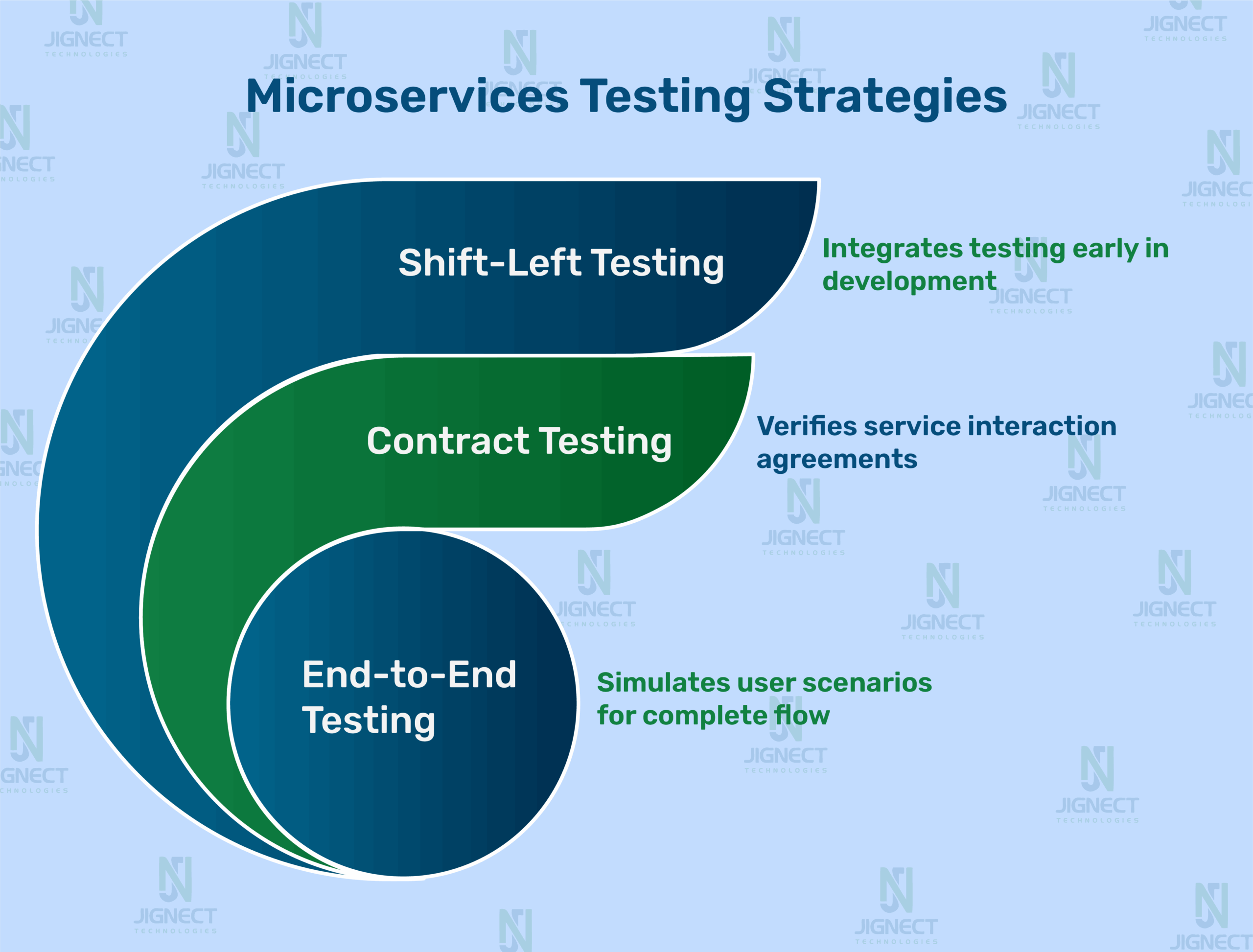
To ensure quality in a microservices architecture, QA must evolve from traditional centralized testing toward a decentralized, layered, and automated strategy. Each service must be tested in isolation, in integration, and across end-to-end workflows.
Below are the most effective QA strategies tailored specifically for microservices systems:
Shift-Left Testing
Early testing shifts towards the left in the software development cycle, specifically to the development and stages.
Why it Matters:
- Early-detection bugs are less expensive and quicker to mend.
- Developers can catch issues before code reaches QA.
How to Apply:
- Implement unit testing, static analysis, and linters as part of the CI processes.
- Implement test-driven development (TDD) in service teams
Tools: xUnit, NUnit, SonarQube, GitHub Actions, GitLab CI.
When to Apply :
- Early in the cycle of development: Integrate testing practices as soon as microservices are scoped and coding starts.
- Use when the developers are working on new service endpoints or refactoring existing logic while developing the feature branch.
- In CI/CD pipelines: Optimal when creating or maintaining build and deployment pipelines in order to have quick feedback loops.
- Onboarding New Services or Teams: Implement to ensure quality standards from day one.
Shift Left Testing Example (Gaming System)
Context
Your game platform has multiple microservices:
- Game Service: handles game sessions and gameplay.
- Balance Service: updates and provides user balance.
- Session Service: tracks game start/end.
- Gateway: routes between services.
You’re implementing Shift Left Testing, meaning you’re testing earlier in the development lifecycle-even before full integration or deployment.
Scenario: “User Starts Game and Balance Updates”
Test Objective
Verify that:
- Game Service correctly requests balance updates via API before the game starts.
- API contract with Balance Service is followed.
- Session Service correctly initiates and terminates a game session.
How You Apply Shift Left Testing
- Mock Balance Service Early
Instead of waiting for the Balance Service to be built or deployed:
- You use mock servers (e.g., Postman Mock Server, WireMock) to simulate expected API responses. This lets you start testing Game Service early, without waiting on other teams.
- Write Contract Tests Early Using Postman or Schema Validation in code:
pm.test("Balance contract is valid", function () { var jsonData = pm.response.json(); pm.expect(jsonData).to.have.property("userId"); pm.expect(jsonData).to.have.property("newBalance"); }); - Now, even before integration, you’re verifying if the API responses meet the Game Service’s expectations.
- Unit Tests for Game Flow Logic In C# (.NET), you write unit tests like:
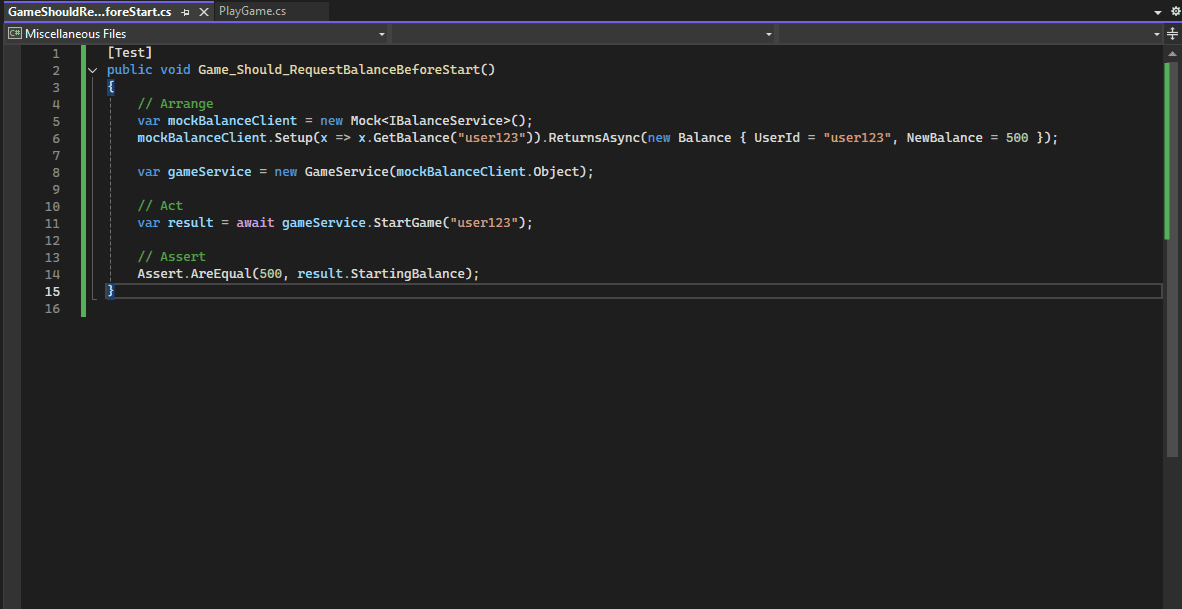
This is unit testing logic and flow without waiting for other services.
Benefits of Shift Left Testing
- Faster Feedback → Catch issues during development, not after.
- API Contracts Stay Safe → Fail fast if other teams break contracts.
- Parallel Development → Teams work without waiting for each other.
- Lower Cost of Fixing Bugs → Fixing early is cheaper.
Contract Testing
Make sure services settle on the communication format and association (the “contract”) between the consumer and the provider.
Why it’s matters:
- Microservices usually develop independently.
- A modification to the API of a service can disrupt a service that uses it.
How to apply:
- Define and verify consumer expectations using tools such as Pact or Spring Cloud Contract.
- Execute contract tests as part of the CI process.
- Tools: Pact, Postman Mock Servers, Spring Cloud Contract
When to Apply:
- Prior to Integrating with External/Internal APIs: Particularly while developing new Consumer-Provider relationships.
- Whenever changes are made to the request or response schemas, even if they are minimal changes.
- Run on a regular basis as part of building pipelines to stop broken contracts from being deployed.
- In Multi-Team Environments: Necessary when teams build microservices in isolation and depend upon common APIs.
Microservice Architecture Contract Testing Test Case Real World Scenario of Gaming
Contract Testing Scenario: Game Service & Balance Service
Goal : Ensure the Game Service (consumer) always receives the expected response structure from the Balance Service (provider), even when the API evolves.
Why Postman for Contract Testing?
While Postman is often used for functional API testing, you can simulate contract tests by:
- Defining expected request/response structure in a collection.
- Using tests tab to assert response fields.
- Automating this via Newman in CI/CD pipelines.
Step-by-Step Setup in Postman
Create Collection: GameService_ContractTests
Request: GET User Balance
- Method: GET
- URL: http://localhost:5001/api/balance/123 (example endpoint)
Expected Response (Contract):
{
"userId": "123",
"newBalance": 100.0
}Tests Tab:
pm.test("Contract: userId should exist and be a string", function () {
pm.expect(pm.response.json().userId).to.be.a("string");
});
pm.test("Contract: newBalance should exist and be a number", function () {
pm.expect(pm.response.json().newBalance).to.be.a("number");
});This fails if the response structure is changed to:
{
"id": "123",
"balance": 100.0,
"currency": "USD"
}Benefits of Postman-Based Contract Testing
| Feature | Benefit |
|---|---|
| Easy Setup | No new tooling if your team already uses Postman |
| Works Locally & in CI | Run tests manually or with Newman in pipelines |
| Fast Feedback | Detects breaking changes during PR validation |
| Lightweight | No need for consumer-provider negotiation setup like Pact |
Summary
- You define contracts in Postman with response structure assertions.
- Game Service developers run these as part of their CI validation.
- If Balance Service breaks the expected contract tests fail early.
- Achieves the same goal of contract testing, without needing Pact.
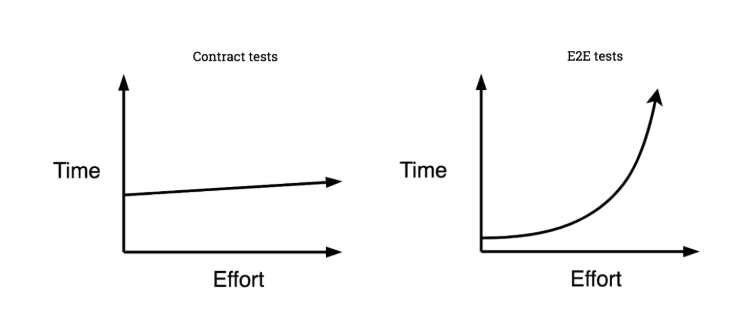
End-to-End (E2E) Testing
Verify end-to-end business processes across different services.
Why it’s important:
- Identifies Areas Where Integration Between Services.
- Simulates real-world use cases from the user standpoint.
How to apply:
- Maintain E2E tests strictly to the critical paths.
- Use them to complement not supplant unit and integration testing.
- Tools: Selenium, Playwright, Cypress, REST-assured
When to apply:
- Prior to Major Releases: Execute E2E testing prior to deployment to staging or production to verify business workflows are working appropriately.
- After Integrating New Services: Validate the effect the new microservice or significant API change will have on current flows.
- Use while testing critical user journeys such as user registration, checkouts, payments, etc.
- In Staging or Pre-Prod Environments: Run in environments closest to production to prevent environment-specific errors.
Microservice Architecture End-to-End Test Case Real World Scenario of Gaming
Scenario: Game Session Lifecycle (Microservices-Based System)
Services Involved
- SessionService – starts/closes game sessions
- GameService – starts/closes the game itself
- BalanceService – manages user balance updates
- GameUI – allows the user to play the game Test Scenario: Full Game Session Flow Use Case: A user initiates and plays a game, their balance updates throughout gameplay, and the system handles automatic session management.
Step-by-Step Flow
| Step | Description | Endpoint/Action |
|---|---|---|
| 1 | Start session – backend service initializes a new session for the user | POST /api/session/start |
| 2 | Start game – launches the game engine tied to the session | POST /api/game/start?sessionId=xyz |
| 3 | Update balance before game – user deposits or gets a bonus | POST /api/balance/update |
| 4 | User plays game via UI – user starts gameplay on UI | UI Action (Selenium simulation) |
| 5 | Game triggers balance update – gameplay (win/loss) affects balance | POST /api/balance/update/from-game |
| 6 | User closes game – signals end of gameplay | POST /api/game/close |
| 7 | System auto-closes session – triggered by backend logic after game close | POST /api/session/close (or automatic internally) |
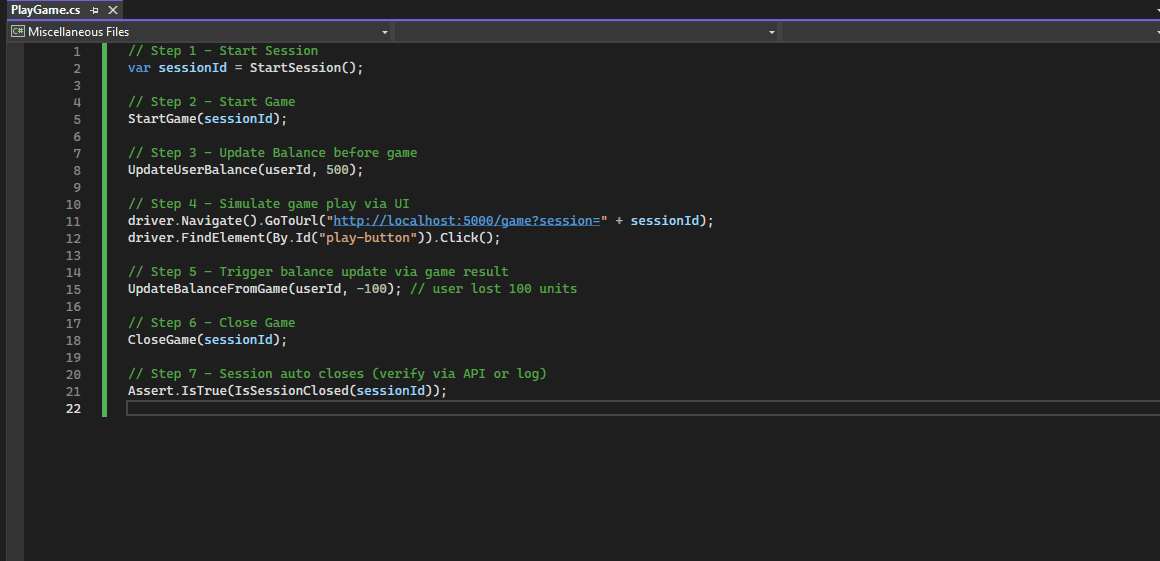
This simulates how microservices are loosely coupled: each service handles one part (session, game, balance).
Tools and Technologies
| Purpose | Tools/Technologies |
|---|---|
| Unit Testing | JUnit, TestNG, xUnit |
| API Testing | Postman, REST-assured |
| Contract Testing | Pact, Spring Cloud Contract |
| Containerization | Docker, Kubernetes |
| CI/CD | Jenkins, GitLab CI, ArgoCD |
| Monitoring | Prometheus, Grafana, ELK Stack |
Real-World Examples
This demo simulates a basic microservices-based product ordering system, implemented in ASP.NET Core using in-memory data for simplicity. It follows best practices in microservices development such as:
- Independent APIs per domain (Product and Order)
- Stateless services
- Separate data models per service
- API Gateway via Ocelot
- Ocelot is an open- source API Gateway created specifically for. NET Core operations.
- It acts as a single entry point for external guests, and also routes incoming requests to the applicable downstream microservices( like your ProductApi or OrderApi). This helps simplify and secure communication in a microservices armature.
- Example in Context :
- A request to http:// localhost5000/ products is routed by Ocelot to ProductApi.
- A request to/ orders is transferred to OrderApi This makes the microservices accessible through a unified, harmonious interface without exposing internal URLs directly.
- Lightweight orchestration using Docker Compose
Project Structure Overview
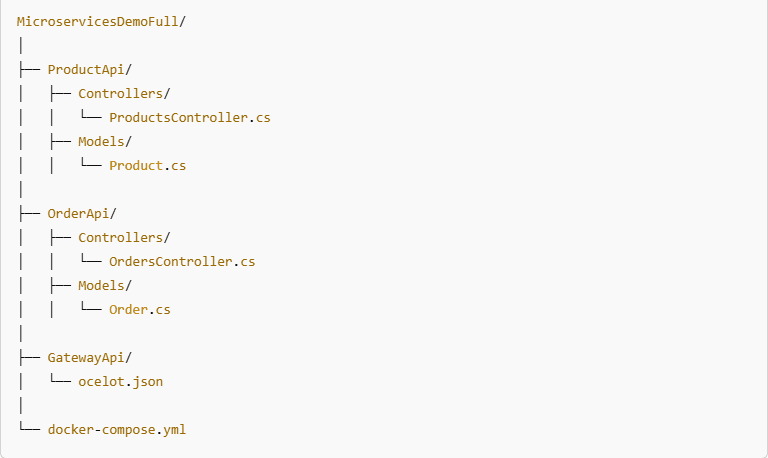
Microservice Breakdown
ProductApi
- Purpose: Manages product data (ID, name, price).
- File: Product.cs Represents the domain model.
- File: ProductController.cs REST API exposing:
- GET /api/products: Lists all products.
- POST /api/products: Adds a new product
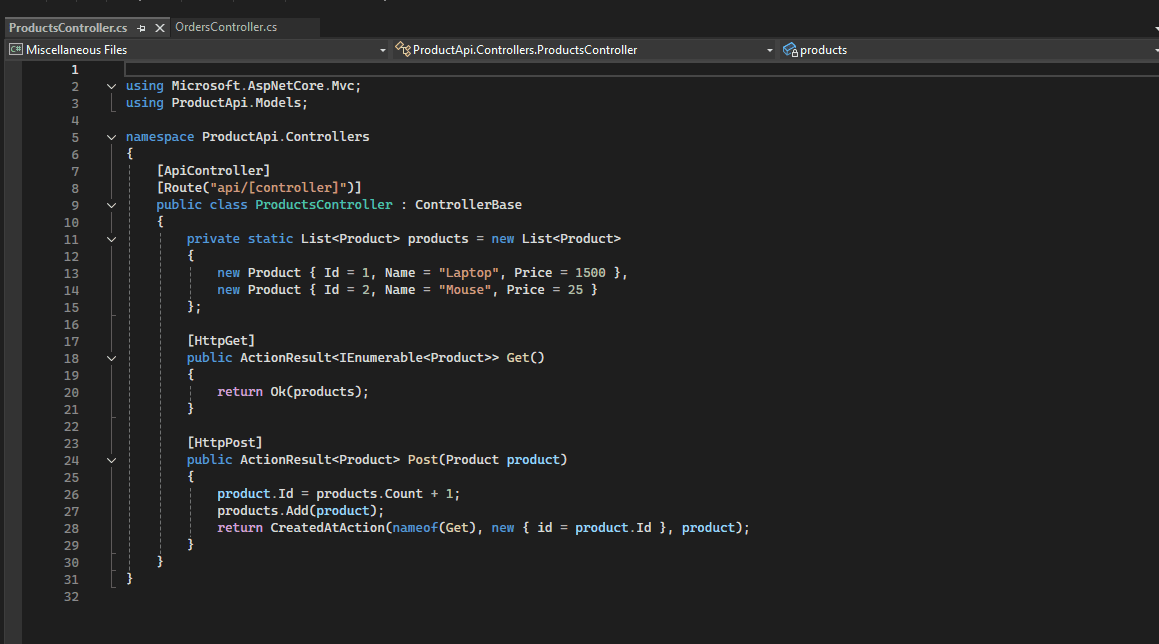
It enables clients to:
- View the list of products (GET).
- Initiate new products (POST).
It employs an in-memory list to mimic database behavior for convenience. This makes it perfect for testing microservices.
OrderApi
- Purpose: Handles placing and tracking product orders.
- File: Order.cs Basic order model (ProductId and timestamp).
- File: OrderController.cs REST API exposing:
- GET /api/orders: Lists all orders
- POST /api/orders: Creates a new order
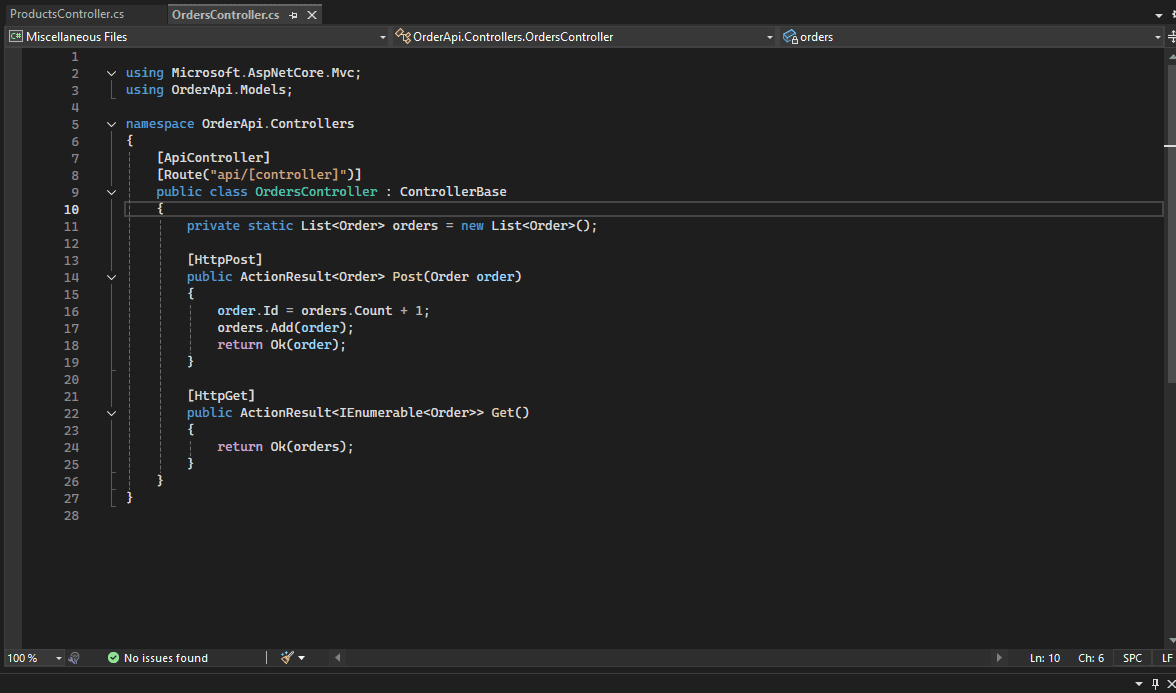
The OrderApi microservice is tasked with creating orders and listing orders. The microservice emulates actual order behavior through the use of an in-memory list so it can remain lightweight and simple to comprehend.
It provides:
- A GET endpoint to retrieve all orders.
- A POST endpoint to make new orders.
It doesn’t verify if the product ID exists in the ProductApi
GatewayApi (Ocelot API Gateway)
- Purpose: A unified entry point for external users to access both services.
- File: ocelot.json Routes incoming HTTP requests:
- /products → ProductApi’s /api/products
- /orders → OrderApi’s /api/orders
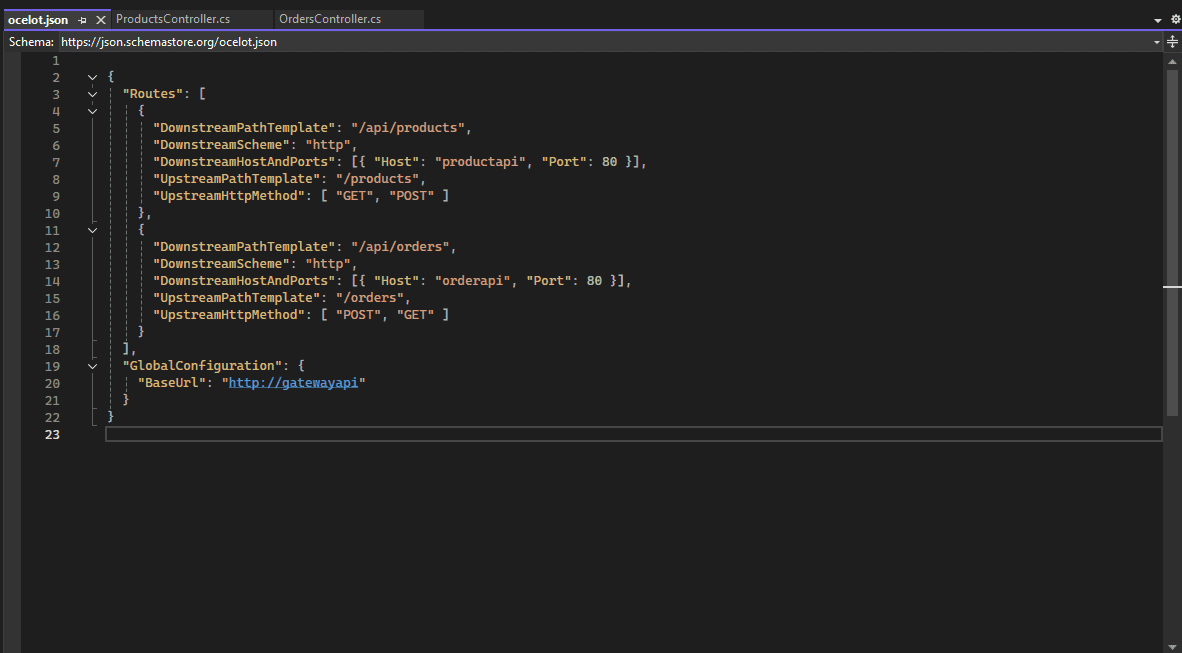
OrderApi is a service to manage customer orders. In microservice architecture terminology, this service will handle order-related logic alone nothing more and nothing less.
The OrderApi is:
- Taking new orders through POST
- Enabling users to see orders through GET
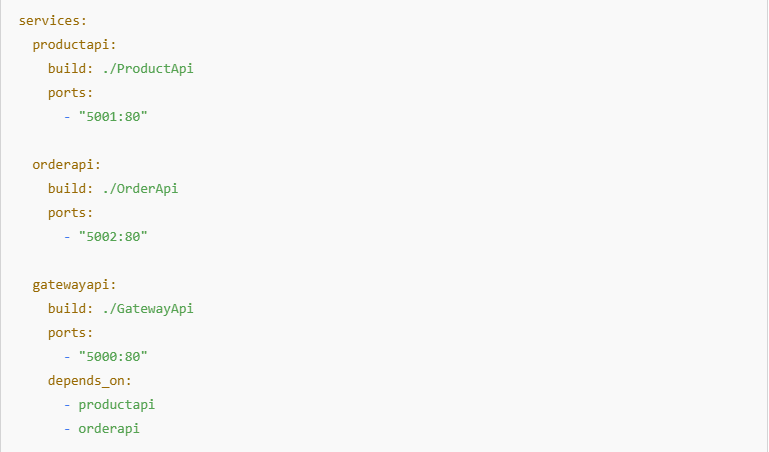
Docker Compose file for running the services using Docker :
- Docker Compose is a tool through which you can define and run multi-container Docker applications using a YAML file. This is particularly handy in microservices, where several services have to be executed at the same time. What’s Inside docker-compose.yml?
They outline the three main services:
- gatewayapi – your gateway api (ocelot).
- productapi – processes product-related requests.
- orderapi – processes order-related requests
What happens when you run docker-compose up?
Here’s a step-by-step explanation:
- Docker Compose processes the YAML file.
- It creates Docker images for
- ProductApi
- OrderApi
- GatewayApi
- It forms containers for each service.
- It maps the ports of your local system to the services.
- They begin all services collectively, and they are ready to communicate.
Example in Action
Whenever you run: docker-compose up
Spins your microservices system up
You can then access:
- Product API via http://localhost:5000/products
- Order API via http://localhost:5000/orders
- (Note: These are routed through the Gateway and not directly to ProductApi/OrderApi)
Sample C# API Tests Using HttpClient (xUnit)
Setup:
Install xUnit via NuGet:
dotnet add package xunit
dotnet add package Microsoft.NET.Test.Sdk
dotnet add package xunit.runner.visualstudio
Create a new test project (if not already):
dotnet new xunit -n MicroservicesApiTests
cd MicroservicesApiTestsTest Code Example
Create a new file GatewayApiTests.cs:
using System;
using System.Net.Http;
using System.Net.Http.Json;
using System.Threading.Tasks;
using Xunit;
public class GatewayApiTests
{
private readonly HttpClient _client;
public GatewayApiTests()
{
_client = new HttpClient
{
BaseAddress = new Uri("http://localhost:5000")
};
}
[Fact]
public async Task Get_Products_ReturnsProductList()
{
var response = await _client.GetAsync("/products");
response.EnsureSuccessStatusCode();
var products = await response.Content.ReadFromJsonAsync<Product[]>();
Assert.NotNull(products);
Assert.NotEmpty(products);
}
[Fact]
public async Task Post_Order_CreatesNewOrder()
{
var order = new
{
productId = 1,
timestamp = DateTime.UtcNow
};
var response = await _client.PostAsJsonAsync("/orders", order);
response.EnsureSuccessStatusCode();
var createdOrder = await response.Content.ReadFromJsonAsync<Order>();
Assert.Equal(1, createdOrder.ProductId);
Assert.True(createdOrder.Timestamp <= DateTime.UtcNow);
}
}
public class Product
{
public int Id { get; set; }
public string Name { get; set; }
public decimal Price { get; set; }
}
public class Order
{
public int ProductId { get; set; }
public DateTime Timestamp { get; set; }
}Run the Tests
- From the terminal:
- dotnet test
Pro Tip:
– Make sure the docker-compose up is already running and the gateway is listening on localhost:5000.
– You can expand this with negative test cases, validations for missing fields, or even mock external dependencies.
Conclusion: Adopting Microservices Architecture with Confidence
Microservices architecture is more than a buzzword it is a strong change in the way we design, construct, test, and scale today’s applications. By decoupling big monolithic applications through independent services, companies can realize increased agility, scalability, and resilience and quicker delivery times.
But taking on microservices adds its own level of complexities, particularly when it comes to quality assurance (QA). From service coordination to data consistency and contract testing to environment parity, each phase requires a new way of doing things with the proper tools and practices.
We have discussed in this blog:
- What is Microservices Architecture and How Does it Differ from Monolithic Architecture
- The main QA challenges microservices introduce
- Proven testing methodologies such as Shift-Left testing, Contract Testing, and End-to-End Testing
- A real-world containerized example utilizing ASP.NET Core, Docker Compose, and Ocelot API Gateway to mimic microservices in action
Regardless if you are a QA engineer, developer, architect, or DevOps practitioner, quality assurance mastery in microservices is pivotal to constructing strong, sustainable systems in today’s distributed landscape.
Witness how our meticulous approach and cutting-edge solutions elevated quality and performance to new heights. Begin your journey into the world of software testing excellence. To know more refer to Tools & Technologies & QA Services.
If you would like to learn more about the awesome services we provide, be sure to reach out.
Happy Testing 🙂




